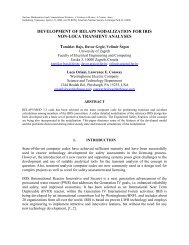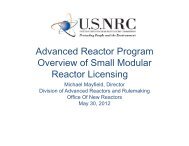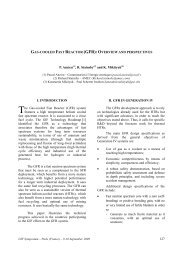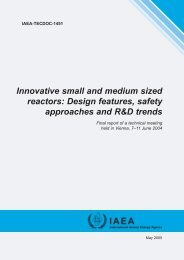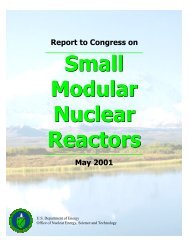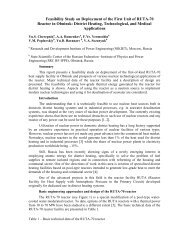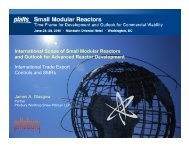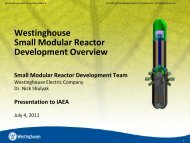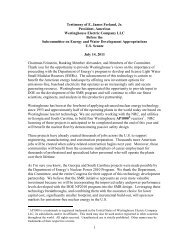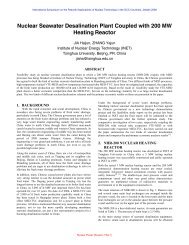Economic and Employment Impacts of Small Modular Reactors - SMR
Economic and Employment Impacts of Small Modular Reactors - SMR
Economic and Employment Impacts of Small Modular Reactors - SMR
- No tags were found...
Create successful ePaper yourself
Turn your PDF publications into a flip-book with our unique Google optimized e-Paper software.
High Nuclear Adoption Case: With high rates <strong>of</strong> added nuclear capacity, moderate rates<br />
<strong>of</strong> <strong>SMR</strong> market share <strong>of</strong> added nuclear capacity, <strong>and</strong> moderate market penetration by<br />
domestic <strong>SMR</strong> manufacturers, almost 40 <strong>SMR</strong>s will be manufactured annually in the U.S.<br />
by 2030. This represents a strong greenhouse gas legislation case.<br />
Moderate Nuclear Adoption Case: With moderate rates <strong>of</strong> added nuclear capacity,<br />
moderate rates <strong>of</strong> <strong>SMR</strong> market share <strong>of</strong> added nuclear capacity, <strong>and</strong> moderate market<br />
penetration by domestic <strong>SMR</strong> manufacturers, an estimated 30 <strong>SMR</strong> units will be<br />
manufactured annually in the U.S. by 2030.<br />
Low Nuclear Adoption Case: With low rates <strong>of</strong> added nuclear capacity, moderate rates<br />
<strong>of</strong> <strong>SMR</strong> market share <strong>of</strong> added nuclear capacity, <strong>and</strong> moderate market penetration <strong>of</strong><br />
domestic <strong>SMR</strong> manufacturers, only a few <strong>SMR</strong> units will be manufactured annually in<br />
the U.S. by 2030. -‐as-‐se.<br />
<br />
capacity, disruptively high rates <strong>of</strong> <strong>SMR</strong> market share <strong>of</strong> added nuclear capacity, <strong>and</strong><br />
moderate market penetration by domestic <strong>SMR</strong> manufacturers, approximately 85 <strong>SMR</strong><br />
units will be manufactured annually in the U.S. by 2030.<br />
‣ An economic analysis estimates the total economic impacts <strong>of</strong> <strong>SMR</strong> manufacturing,<br />
construction, <strong>and</strong> operation <strong>of</strong> a representative 100 MW <strong>SMR</strong> unit.<br />
A prototypical 100 MW <strong>SMR</strong> costing $500 million to manufacture <strong>and</strong> install on-‐site is<br />
estimated to create nearly 7,000 jobs <strong>and</strong> generate $1.3 billion in sales, $627 million in<br />
value-‐added, $404 million in earnings (payroll), <strong>and</strong> $35 million in indirect business<br />
taxes.<br />
The annual operation <strong>of</strong> each 100 MW <strong>SMR</strong> unit is estimated to create about 375 jobs<br />
<strong>and</strong> generate $107 million in sales, $68 million in value-‐added, $27 million in earnings<br />
(payroll), <strong>and</strong> $9 million in indirect business taxes.<br />
‣ Given the expected number <strong>of</strong> <strong>SMR</strong>s to be manufactured in the U.S. under each <strong>of</strong> the four<br />
market analysis scenarios, the economic analysis projects the maximum economic impacts <strong>of</strong> a<br />
developing domestic <strong>SMR</strong> industry through 2030. 2<br />
High Nuclear Adoption Case: In 2030, the domestic manufacturing <strong>and</strong> construction <strong>of</strong><br />
<strong>SMR</strong>s will be responsible for an estimated 255,000 jobs annually, $48.3 billion in annual<br />
sales, $23.2 billion in annual value-‐added impacts, $15 billion in annual earnings, <strong>and</strong><br />
$1.3 billion in annual indirect business taxes. Cumulatively through 2030, the domestic<br />
2 These projections do not include support service revenue <strong>and</strong> job impacts from enrichment services. Several<br />
<strong>SMR</strong> designs assume uranium enrichment levels higher than those associated with conventional reactors. This<br />
study uses a prototypical light-‐water reactor design to model economic impacts, <strong>and</strong> the study team assumed the<br />
generic design would not require a higher enrichment level. In addition, the study team assumed growth to be<br />
linear between the low-‐point in 2015 to a high-‐point in 2030. Therefore, if actual manufacturing <strong>of</strong> <strong>SMR</strong> units<br />
begins after 2015, a corresponding linear shift in the economic outputs would likely occur in the years after 2030.<br />
6



